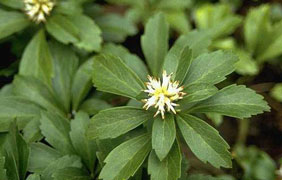


Home
Flowers &
Indoor Plants
Fruits & Nuts
Ornamentals
Vegetables
Special Topics
Resources
Glossary

|
Japanese Spurge Pachysandra terminalis (pack-i-sand-rah term-i-nall-iss)    Click on thumbnails for larger image. |
 |
What about it? The spurge is a low, broadleaf, evergreen groundcover with alternating leaves. The leaves emerge in clusters from green steins. Spurges tend to grow in a dense formation and their maximum height is 12 inches. In early May white flowers will appear. "Variegata" is a popular variety that has white leaf margins. What is it used for? The Japanese spurge is utilized primarily as a decorative groundcover or on sloped banks to control erosion. Where does it grow? How do we grow it? Spurges enjoy partial shade and moist, well-drained soil. Unless these conditions are met you will have difficulty getting a spurge established. Weeding will be necessary to fend off competitive grasses until the spurge gets big enough to fight its own battles. Sometimes people will interplant spurges with bulbs. Nonetheless, a spurge will need 6-12 inches of growing space. What are its primary problems? Japanese spurges are particular about their growing sites so select a good site carefully. They will not grow well in full sun or in poorly drained areas. Volutella blight can be a problem on injured plants or in plantings that are too crowded. the are also plagued by a fungal leafspot. Scale insects can also attack pachysandra.
© Copyright, Department of Horticulture, Cornell University. |